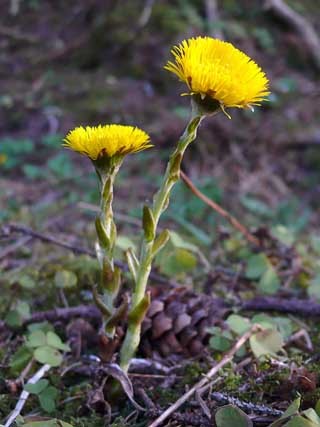Tussilago farfara
Family: Compositae (formerly Asteraceae)
Common Names: coughwort, bullsfoot, foalswort, horsehoof,
Parts used: leaves, flowers, roots
Description: Coltsfoot is a perennial plant that looks similar to a dandelion when it blooms in spring. This wild edible plant is unusual in that the flowers bloom and die before the appearance of any leaves. One of the first plants to flower in late winter, heralding the beginning of spring.
Grows in poor, disturbed soils, along roadsides and waste places. It has long-stalked, hoof-shaped leaves (hence the common name), about 4 inches across, with angular teeth on the margins. Both surfaces are covered, when young, with loose, white, felted woolly hairs, but those on the upper surface fall off as the leaf expands. This felty covering easily rubs off and before the introduction of matches, wrapped in a rag dipped in a solution of saltpetre and dried in the sun, used to be considered an excellent tinder
Actions: anti-tussive, anti-inflammatory, demulcent, expectorant and tonic
Constituents: All parts of the plant abound in mucilage, and contain a little tannin and a trace of a bitter amorphous glucoside. The flowers contain also a phytosterol and a dihydride alcohol, Faradial
History and Lore
From A Modern Herbal:
An old name for Coltsfoot was Filius ante patrem (the son before the father), because the star-like, golden flowers appear and wither before the broad, sea-green leaves are produced The botanical name, Tussilago, signifies 'cough dispeller,' and Coltsfoot has justly been termed 'nature's best herb for the lungs and her most eminent thoracic.' The smoking of the leaves for a cough has the recommendation of Dioscorides, Galen, Pliny, Boyle, and other great authorities, both ancient and modern, Linnaeus stating that the Swedes of his time smoked it for that purpose. Pliny recommended the use of both roots and leaves. The leaves are the basis of the British Herb Tobacco, in which Coltsfoot predominates, the other ingredients being Buckbean, Eyebright, Betony, Rosemary, Thyme, Lavender, and Chamomile flowers. This relieves asthma and also the difficult breathing of old bronchitis. Those suffering from asthma, catarrh and other lung troubles derive much benefit from smoking this Herbal Tobacco, the use of which does not entail any of the injurious effects of ordinary tobacco
In Paris, the Coltsfoot flowers used to be painted as a sign on the doorpost of an apothecary's shop
Medicinal Uses and Formulas
In my opinion, the best way to take coltsfoot is to go take a walk when she's in bloom and eat her stalk and flower fresh. When you pick one, try to find a patch that's not too close to the road, preferably uphill from the embankment. The texture on the mouth is a lot like the feeling of eating a dandelion blossom. There's a pungent, acrid taste, but it's also very sweet with not nearly as much bitterness as a dandelion. What a beautiful spring tonic! It's also wonderful as a remedy for those persistent coughs and colds that come with the late winter/early spring.
Traditionally, both flowers and leaves make an excellent cough remedy, although you have to wait a little longer for the leaves to appear. Often combined with horehound, marshmallow and licorice or elecampagne. Commonly made as a syrup or tea.
For tea, steep 1-2 teaspoons of leaves or flowers in 1 cup boiling water.
For a syrup, make a decoction of 1 OZ. of leaves, in 1 quart of water boiled down to a pint, sweetened with honey or licorice, and taken in teacupful doses frequently. This is good for both colds and asthma.
Drink no more than 3 cups daily.
While I have no experience with this, I've heard it can also be smoked by those with asthma, bronchitis and other lung problems, particularly those involving wet coughs.
Hot or cold coltsfoot tea compresses can be applied to swollen areas, and a cool such compress is soothing on the forehead or stomach when one has a fever.
A poultice of the leaves or flowers can be applied to eczema, sores, ulcers and insect bites.
The root is also useful for similar purposes, but it has higher levels of potentially toxic alkaloids and it is not recommended that it be used internally. All parts of coltsfoot contains these alkaloids, which can cause liver disease, but the leaves and flowers are considered safe for normally healthy adults to use in moderation. If you still aren't better after a few days, switch off with mullein for awhile.
Spiritual and Energetic Attributes
One of my favorite of the early spring blooms, some of coltsfoot's strongest medicine is in her ability to uplift and encourage us that brighter days are coming. She rises to greet me in my dullest of winter-weary March moods, when I just about weep to see such a bright color. She always changes my mindset. I love that in a plant.
Unlike the woodland spring 'ephemerals' that get so much press, coltsfoot is hardy and humble. She grows along asphalt roads and drainage ditches - mundane places no delicate spring ephemeral could tolerate. And yes, she's common. But I love that about her too. She is there on my ordinary walks to and fro on the neighborhood roads, not just on the special hikes into the deep woods.
The idea of medicine for the soul is embodied in coltsfoot's brazen, early spring leap. Just go for it, she says. Don't bother looking, just take the leap. Like the Fool of the Tarot, she springs into action without looking or caring what's ahead.
She's available, abundant, and exuberant. Each year, I get the sense that she's happy to see me, like that bubbly child who rushes up and sequels and gives a big hug, like you're the best thing shes been waiting for! And I swear, she giggles when I pick her and eat her.
Coltsfoot is one of the first flowers to emerge in the springtime, often appearing as early as February. This and its bright sunny yellow flowers make it suitable for springtime rituals welcoming the return of the sun, such as Imbolc, Ostara and Beltaine- depending on when they bloom that particular year! The long stems can be woven into wreaths.
In olden times, coltsfoot was used by country healers on Europe as a visionary and love herb – burned in rituals to increase psychic and visionary abilities. Carried as charm for love and good fortune.
Precautions
Do not confuse common coltsfoot with Western coltsfoot Petastites frigidus, which has much higher levels of potentially toxic alkaloids. This plant may not be used to substitute for the other under any circumstance.
Coltsfoot, like comfrey, has come under fire for containing pyrrolizidine alkaloids which can cause liver damage. There's been much controversy regarding appropriate use of these plants, with some people calling for their use to be banned altogether. That being said, Tylenol contains these same alkaloids. One of the most helpful bits of advice I've heard about plants containing these alkoloids is to take the same precautions with coltsfoot (and comfrey) as you would with Tylenol.
Don't combine coltsfoot with blood pressure medication. People who are allergic to ragweed are also likely to be allergic to coltsfoot, proceed with caution. People with a history of alcohol abuse or liver disease should not take coltsfoot. Do not combine coltsfoot with other potentially liver damaging substances, such as acetaminophen (Tylenol) or comfrey.
If you ever begin to feel nauseated while using this herb, stop immediately. It is not a "normal" side affect, but a sign that the coltsfoot is hurting your liver.



